Beverly Gray's Blog: Beverly in Movieland, page 8
January 7, 2025
A (Semi) Golden Evening at the Golden Globes

Who votes for the GoldenGlobes, anyway? The top-of-the-year awards ceremony used to be hosted by theHollywood Foreign Press, a small cadre of foreign journalists known for theireccentricity, their snootiness, and their willingness to be bought by thehighest bidder. (A “new star of the year” statuette for Pia Zadora? Really?)
After an outcry a few yearsback about the group’s ongoing racist inclinations, there was a complexreshuffling of the Globes’ voting bloc, and I don’t pretend to know who’s incharge now. I do know, though, several key things. First of all, that the eventstill tries to present itself as the awards season’s best party, with attendeesserved a festive dinner and booze flowing like water. Secondly, that awards goto both movie and TV bigshots (crafts categories are pretty much ignored). And,thirdly, that best picture and best actor awards are divided between dramas, onthe one hand, and comedies or musicals on the other. This divvying up of filmsby genre perhaps made sense at one time: at the Oscars great comic performanceshave often been overlooked in favor of actors playing dead-serious roles.But the categorizing at the Globes often leads, as it did this year, to somehead-scratching choices. Take the Best Motion Picture—Musical or Comedycategory. It’s easy to see that Wicked belongs there. But what about Anora, A Real Pain, The Substance, andthe ultimate winner, Emilia Pérez? Yes, they might contain hilarious moments,but films in which the heroine suffers a ghastly fate don’t strike me asfundamentally funny. Nor does a movie whose climax is a visit to a Polishconcentration camp.
Host Nikki Glaser, who’s beenreceiving major plaudits for her performance, got off some good lines in heropening monologue, which nicely skewered Hollywood pomposity. I enjoyed herintro of “two-time Holocaust survivor” Adrien Brody, but particularlyappreciated her canny reference to “the hardest-working actors in the room,”the ones that were busy serving the meal on which celebrities in tight outfits werecautiously nibbling. In the later innings, though, Glaser didn’t seem to havemuch to say. She DID show up in a series of glamorous gowns, each designed toshow us she has two breasts in working order. (Breasts were definitely star attractionsamong the ceremony’s female contingent.) At one point Glaser started in on asong mashing up Conclave and Wicked’s “Popular.” I had high hopesfor comedy gold, but her “Pope-ular” stopped almost as soon as it started. Asfor other great funny moments, fuhgeddaboudit . . . except when an impish SethRogen and a priceless Catherine O’Hara admitted to the awards they’d supposedlywon (like The Golden Antler and The Beaver) in their native Canada. Theirs wasthe only appearance that had me laughing out loud.
What about the winners? Theprize for most emotional definitely went to Best Female Actor in a SupportingRole (yes, that’s how they put it), Zoe Saldaña, who seemed overcome by her winto the point of choking up, and then couldn’t stop talking. Having seen EmiliaPérez, I agree that she earned her award. Almost equally emotional (andequally voluble) was Adrien Brody, Best Male Actor in a Motion Picture--Dramafor another much-honored flick, The Brutalist. Demi Moore was articulateand touching in explaining how The Substance (a comedy??) gave her a newlease on her professional life, in keeping with the film’s own themes. But the#1 surprise was Fernanda Torres of Argentina, for the Brazilian I’m Still Here,beating out some of Hollywood’s finest. This I’ve gotta see!
January 3, 2025
A Change for the Better: “Emilia Pérez”

A friend with a stronginterest in movies has chosen not to see Emilia Pérez. He said he just couldn’t get excitedabout a film that focused on a Mexican crime lord’s sexual transition from maleto female. The fact that it is a musical made it seem, to him, even odder. AndI admit I had something of the same feelings. I’m a bit overwhelmed, right now,regarding movies (and other art forms) that focus intensely on genderdysphoria.
But then Emilia Pérez showedup on Netflix, which meant I could watch it for free. And I was certainlycurious (though not yellow) to see why this film set the Cannes Film Festivalabuzz, and won a Best Actress prize to be divided among its featured femaleensemble. The actresses included Latin American stars Zoe Saldaña and SelenaGomez, along with Karla Sofía Gascón, a Spanish performer who transitioned from male tofemale in 2018. Gascón has been mentioned as a possible Oscar nominee, and Ican see why. In the film’s early going, she is featured as a gruff,tremendously fearsome cartel boss who is not in the least feminine. As Juan"Manitas" Del Monte shesummons a talented but underappreciated female attorney (Saldaña) andforcefully explains her desire to leave her current life—whatever the cost—andbecome a woman. There follow several rather goofy musical segments in whichSaldaña travels the world, looking for doctors who are both discreet and adeptat sexual reassignment surgeries. For the right price, it’s amazing how manyservices are available. An add-on procedure to remove the “Adam’s apple”? Sure.
I enjoyed all of the above,but couldn’t see why French writer- director Jacques Audiardwas racking up major honors for this film. But once Manitas becomes Emilia, thefilm radically changes its tone. Whereas Manitas was imperious and cold, Emiliais warmth personified. In her new and quite attractive body, she’s positivelyglowing. But she’s no longer just interested in self-satisfaction. Now, with Saldaña’sRita as her lieutenant, she’s started a major charity to help mistreated women.(Rita’s mixed emotions are striking. When Emilia suckers a large group of druglords into showing up at a banquet to support her group, Rita acts out hercontempt for these potential benefactors in a remarkable fantasy number thatshows off her stunning dance moves.)
The film’s musical numbershave the virtue of reminding us that this story is built on fantasy. But thefantasy co-exists with some tender moments that are deeply felt, like Emilia’sgrowing longing to be with the young children she once sired, and her littleson’s hunch that his newly arrived “aunt” is somehow closer to his absentfather than she might seem. Love is in the air in all its iterations: Emiliaforms a romantic bond with a needy young wife who’s glad to be rid of herabusive husband. Meanwhile, Selena Gomez’s Jessi, believing herself the widowof the absent Manitas, falls for the slimy Gustavo and helps hatch a desperateplan that will dominate the film’s last section. Alas, surprises await.
What’s this movie saying? Thatwomen are better (if not necessarily stronger) than men? That seems much toosimplistic a conclusion. And Gomez’s Jessi, for all her moments ofself-reproach, is hardly saintly. Let’s just say Emilia Pérez is aboutthe value of being true to your authentic self. Manitas was once hated andfeared. But Emilia, at film’s end, is recognized as a hero, even a saint. As awoman, she brings her community together, instead of tearing it apart.
December 31, 2024
Reviving “Shaun of the Dead”
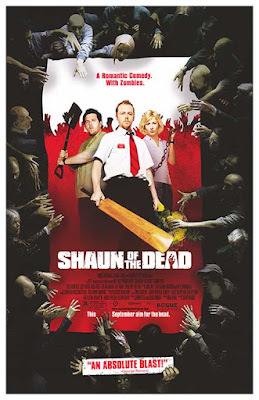
As we all know from movies asvaried as Dracula and Twilight, vampires can be sexy. Zombies,though, not so much. A zombie apocalypse means a large (and growing) contingentof slobbering undead humanoids staggering through the streets, on the trail ofhuman victims who are fated (once bitten) to turn into zombies themselves.Yuck!
I’ve learned that the conceptof a zombie developed out of Haitian folklore, involving the resurrection ofdead souls. The word “zombie,” adapted from African languages, entered Englishin 1819, via poet Robert Southey’s history of Brazil. But our current obsessionwith zombies can be credited mostly to filmmaker George A. Romero, whose spooky1954 low-budget horror flick, Night of the Living Dead, was followed bytwo equally popular sequels. Michael Jackson helped too: in his 1983 musicvideo, “Thriller,” ghoulish creatures rise from their graves and foot-drag downthe sidewalk in pursuit of potential victims.
Clearly, zombies are not alot of fun. Except when it comes to an unlikely zombie comedy that borrows thetitle of Romero’s second film, Dawn of the Dead. In that 1978 drama,zombies take over an all-American suburban shopping mall, with bloody results.In 2004, director Zack Snyder came up with a Dawn of the Dead remake: heassembled an all-star cast (Sarah Polley, Ving Rhames, Ty Burrell) as mallclerks and shoppers fending off the inevitable carnage. That same year broughta British film that gave “stiff upper lip” a new meaning. Comicwriter/performers Edgar Wright and Simon Pegg set their story in the Crouch Endsection of London. In their telling, vividly directed by Wight, the zombieapocalypse challenges the laid-back lifestyle of two slackers (vividly playedby Pegg and comedian Nick Frost) who are mostly oblivious to the world aroundthem. Belatedly getting their cues from a newsreader on their big-screen TV,they try staving off the marauders by flinging disks from their recordcollection (like, for instance, the Batman soundtrack), but discoverthat a cricket bat works better. Still, while Shaun discovers in himself someunexpected leadership qualities, the easily distracted Ed keeps ducking out toeat ice cream and play video games. Eventually a cluster of survivors ends upinside Shaun and Ed’s favorite pub, with zombies trying to break down thewindows.
Though it’s impossible totake any of the above too seriously, there’s still some real pathos in Shaun’svaliant attempts to protect his ex-girlfriend (who eventually finds new respectfor this doofus) and his mother (who does her best to accept some dramaticchanges in her comfortable life). I’ve read that none other than Helen Mirrenwas offered the mother’s rather surprisingly poignant role, though she turnedit down; veteran actress Penelope Wilton (of The Best Exotic Marigold Hotel)is a fine substitute. But perhaps the single most vivid performance is turnedin by the always memorable Bill Nighy, who plays Shaun’s stepdad. At first he’sa grouchy middle-class type, proud of his Jaguar and carpingly critical of hisstepson. But as the supernatural invaders close in, his deeply-felt apology toShaun is touching . . . and then, well, Nighy is singularly creepy when he’sundead.
I won’t spoil any more of the plot. But it’sworth noting that George Romero—Mr. Zombie himself—was delighted by Shaun ofthe Dead, to the point that he offered Wright and Pegg roles in his 2005 Landof the Dead. Both turned down the parts he had reserved for them andinsisted on appearing as zombies, among hordes of others. They wanted, I’mguessing, to know how the other half “lives.”
December 27, 2024
The Colorful Drama of Purple Noon
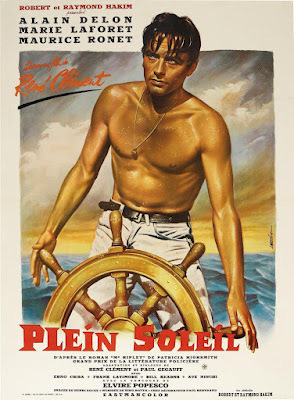
The recent passing of Frenchleading man Alain Delon called my attention to the fact that, at the start of along career, he first hit it big in René Clément’s 1960 thriller, PleinSoleil, known to American moviegoers as Purple Noon. I never sawthis film until recently, but its title instantly had meaning for me. Back whenI was in high school, my French teacher handed out extra credit for variousexperiences involving the French language. If you dined at a local Frenchrestaurant and swore that you’d spoke en français to the waiter, you gotpoints. (This proved very popular with my family, all of whom loved theopportunity to further my scholastic career by dining out.) You also got pointsfor attending a French-language film and trying hard not to read the subtitles.Most of us kids, thoroughly brainwashed by Hollywood, had no interested inchecking out a film in French. And our teacher, in recommending Purple Noon (thenplaying at a local art house), said nothing to convince us that we’d actuallyfind this film entertaining. As a consequence, I missed out on more extracredit, as well as a chance to see a really fascinating cinematic game ofcat-and-mouse.
Purple Noon (certainly a garish title) turns out to be the firstscreen adaptation of Patricia Highsmith’s famous 1955 thriller, The TalentedMr. Ripley. Forty-four years later, Anthony Minghella wrote and directed amuch more complicated English-language version. It starred a young Matt Damonand featured such rising talents as Gwyneth Paltrow, Jude Law, Cate Blanchett,and Philip Seymour Hoffman in a tale of a young man who’ll go to any lengths(including bloody ones) to achieve the lifestyle he feels he deserves.Highsmith herself strongly preferred Delon’s take on Tom Ripley, which reliesless on pathos and more on the audience’s ability to identify with a young manwhose creative improvisations help him get what he wants out of life.
It's been pointed out thatRipley’s story goes well into film noir territory, but shifts theformula by being shot in brilliant color in some of the world’s mostbeautifully sunlit places. Much of the action of Purple Noon takes placeon a gorgeous yacht off the coast of Italy. That’s where a feckless, and verywealthy, young San Franciscan named Philippe Greenleaf sets out on a cruisealong with his fiancée, Marge, and his amusing new buddy, Tom Ripley. Philippeis not a very gracious host, especially after he discovers Tom trying on hisclothes. What happens between them sets the stage for a series of deceptions inwhich Tom, back on shore, creatively pretends (with the help of a portabletypewriter and some glue) that Philippe is alive and well, happily ensconced ata local hostelry. His on-and-off masquerade as Philippe leads to additionalmayhem, as well as to his passionate wooing of Marge, for reasons thateventually become all too plain.
It's curious (and perhapsdisturbing) that British author Highsmith imagined Tom Ripley as aborn-and-bred American. Her multiple follow-up novels to The Talented Mr.Ripley have led to several additional films as well as a 2024 Netflixminiseries. Obviously, this is a young man whose exploits we love to follow,even if we don’t consider him a model of wholesome behavior. The Frenchversion, Purple Noon, largely sidesteps the novel’s obvious homoeroticsubtext: what else would you expect in 1960? Still, this is a marvelous introto a sinister but fascinating world. Too bad it’s too late for me to get extracredit.
December 24, 2024
Dishonor Among Thieves: Big Deal on Madonna Street
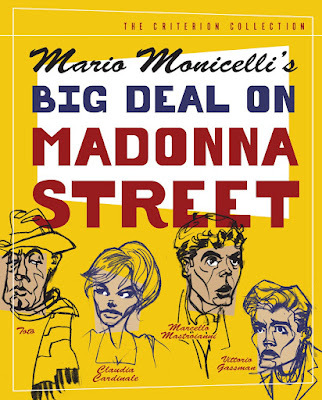
I’m not quite sure why we allgravitate toward movies about crime rings. Maybe they spice up our humdrumlives by allowing us to enjoy vicariously the thought of operating outside thelaw. In any case, moviedom is full of memorable crime caper films. Sometimesthe crooks get away with murder, so to speak; sometimes they are foiled by theirown hubris. In any case, these caper films give us viewers a great deal ofenjoyment, as we watch characters doing things we’d never personally dare try.
One of my absolute favoritesin this genre is 1964’s Topkapi, in which a ring of thieves finds adaring way to break into an Istanbul palace to steal a jewel-encrusted dagger.It boasts fabulous location work, an Oscar-winning comic performance by thegreat Peter Ustinov, and genuine suspense leading up to a twist we don’t seecoming. Topkapi was directed by American expatriate Jules Dassin, who ofcourse folded his delightful wife Melina Mercouri into the ensemble cast. Nineyears earlier, Dassin had won acclaim for a much darker heist film, theParis-set Rififi. As anyone who’s seen it will tell you, the heart ofthis low-budget flick is a deeply suspenseful 30-minute segment in which thecentral characters, operating in almost total silence, crack open the safe of ahigh-end Parisian jewelry store. The heist is a smashing success, but from thenon things don’t go so well.
It was partly as a spoof ofneo-realist crime films like Rififi that Italian filmmaker MarioMonicelli launched I soliti ignoti, known in Britainas Persons Unknown and in the U.S. by a far more colorful title, BigDeal on Madonna Street. Shot in black & white on the streets of Rome,it captures a milieu where pretty much everybody is up to no good. Here’s oneof my favorite early exchanges, one that nicely sets the tone for what’s tocome:
:Tell me, do you know a guy called Mario who lives around here?
Boyplaying soccer: There are a thousand Marios around here.
:Yes, but this one is a thief.
Boyplaying soccer: There are still a thousand.
At the heart of the film is amotley crew made up of ex-cons who are not exactly the sharpest tools in theshed. One is a clumsy thief who keeps getting himself arrested; one isfanatically trying to keep his pretty and unmarried sister (a very youngClaudia Cardinale) under lock and key; one wizened old guy can’t resiststealing anything (a loud alarm clock, for instance) that comes his way.Vittorio Gassman, mostly known for dramatic roles, plays a glass-jawed boxerfor whom smart thinking only happens with great difficulty. MarcelloMastroianni is a frazzled husband stuck with the care and feeding (not tomention the diaper-changing) of his baby son. Against all odds, they manage tobreak into an empty apartment that’s supposed to lead them into the lucrativepawnshop next door. So they’re drilling holes in walls, but not exactly theright walls. Which leads to a comic scene in which they pretty much give uptheir criminal ambitions to enjoy a can of beans in their victims’ kitchen.
In 1986,director/choreographer Bob Fosse tried staging a Broadway musical version,called Big Deal. Set in 1930sChicago, it featured a largely African-American cast and popular songs of theera (like “Just a Gigolo” and “Ain’t We Got Fun?”). Big Deal ran for 69performances in 1986. It received five Tony Award nominations, with Fossewinning for his choreography. No one has seemed inclined to revive it.
December 19, 2024
Good Guys and Bad Guys: Roger Corman’s People
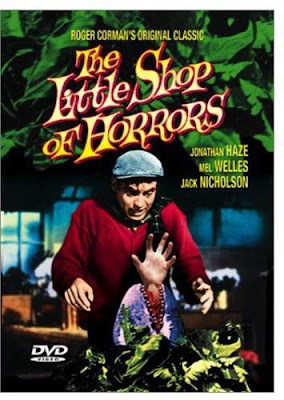
As director Joe Dante oncetold me about our mutual former boss, Roger Corman, “The thing about Roger is that you meet him onyour way up, and if you’re not lucky you meet him again on your way down.” Joewas talking specifically about Peter Bogdanovich, who got his start with Roger,then later revived his flagging career by co-writing and directing a 1979Corman release, Saint Jack.
Though Joe’s commentreferenced filmmakers, I think it applies to actors as well. At least, it’strue that name performers who were on a downward slide could often find a juicyrole in a cheapie Corman flick. F. MurrayAbraham, who had won an Best Actor Oscar for playing Salieri in 1984’s Amadeus, showed up—to mysurprise—as the second lead in Corman’s 1995 gangster thriller, Dillingerand Capone. When we were casting something called Hellfire, a luridperiod drama to be shot in Russia, I was astounded that the casting choices forthe role of a powerful but fading beauty included an award-winning stageactress known for her serious roles and a once-charming ingenue who had starredin a popular Broadway musical. (Ultimately the role went to a former Cormanregular, Beverly Garland, who dated back to his early days.) And for theleading man in a Vietnam War drama, we cast a once-popular TV actor whosecareer had been derailed by his alcoholism. I heard that in one key scene, he had to be barefoot, because his feetwere so swollen from a recent binge that his military boots no longer fit.
Yes, Corman’s movies oftenfeatured stars whose careers had stalled. But he also, at least in thebeginning, had a loyal stock company of aspiring thespians who would do justabout any job and play just about any role. The group included Beverly Garland,Mel Welles, and a very young Jack Nicholson, who is still deeply grateful toRoger for giving him a start. But I havea special affection for Dick Miller, whom I came to know in my New WorldPictures days. Dick, a pugnacious little guy who started out aiming to be awriter, played just about any role given to him: an Indian, an astronaut, adoor-to-door vacuum cleaner salesman. His crowning performance was as awould-be sculptor who accidentally becomes a murderer (and a celebrity) in1959’s A Bucket of Blood. Dick’sbrilliant work as a nebbish who just wants recognition led to Roger wanting tocast him the following year as Seymour, the hapless flower shop assistant whonurtures a man-eating plant, in 1960’s The Little Shop of Horrors. ButDick, always stubborn, felt the part would be a repeat of his previousperformance. That’s why he took the far smaller role of the petal-munchingBurson Fouch, and Jonathan Haze finally got his big break.
When I wrote my Cormanbiography, I never formally interviewed Haze, and I didn’t meet him until yearslater. To be honest, I was intimidated by the thought of approaching the starof Little Shop of Horrors. The pathos in Jonathan’s performance washilarious. But unlike Dick Miller, he never became a favorite of Corman alumnidirectors like Joe Dante and Martin Scorsese. And there was certainly no documentary made about his career. (Cf2014’s That Guy, Dick Miller.) Yet Jonathan, much committedto physical fitness and a healthy lifestyle, outlived Roger and the rest of thegang. He died November 5, at age 95. Rest in peace, Jackie Haze!
Farewell, too, to MichaelVillella, the blood-thirsty Driller-Killer in the original Corman Slumber PartyMassacre.
December 17, 2024
Feeling a Real Pain at the Multiplex

I had looked forward forweeks to seeing the new film written and directed by Jesse Eisenberg, of TheSocial Network fame. A Real Pain is a serious but at times veryfunny indie about two first cousins traveling to today’s Poland as part of aJewish Heritage tour. Their Polish grandmother was a Holocaust survivor, and ofcourse the memories of that 20th century tragedy inform the film,which includes a genuinely solemn visit to the actual Majdanek deathcamp near Lublin. But the focus is on the two young men whose more comfortablelives in America have not saved them from a deeply internalized sort of pain.
The two are played byEisenberg himself and by Kieran Culkin, who recently scored big with the TVminiseries, Succession. As per usual, Eisenberg plays a neurotic type,outwardly living a wholesome life with a wife, a kid, and a high-tech job, butinwardly a bundle of nerves. Culkin, who has received major attention for hisrole, is the apparent free spirit, still smoking weed in his mother’s basementwhile deciding what he wants to do when he grows up. His Benji Kaplan is,though, much more complicated than that. Yes, he knows how to have fun, and helives by the mantra that rules are meant to be broken, but at times hedissolves into a profound grief from which he cannot easily be rescued.
Naturally, these two interact,with varying degrees of success, with the others on the tour: an older couple, adeeply spiritual Rwandan convert to Judaism, and a middle-aged woman (JenniferGrey) dealing with relationship problems of her own. There’s also an earnestBritish tour guide who is not Jewish but is somehow caught up in the tragedy ofthe European Jewish story. What’s instructive—and highly believable—is how hardall of these fellow travelers are trying to show their best selves on a journeyso fraught with emotion.
So, yes, I really liked thefilm. In its modest, concise way, it has a great deal to say about pain and itsmanifestations, large and small. There was only one problem. We all know thatwhen movies are coming into theatres, exhibitors show “coming attractions”trailers designed to arose the curiosity of the moviegoing public. Thesetrailers are meant to be enticing, but at times they try a little too hard. Itso happens that I saw A Real Pain at the Santa Monica branch of theLaemmle theatre chain. The Laemmles, related to the long-ago honcho ofUniversal Studios, have been for decades a family dedicated to screening greatindependent films. (Their motto: “Not Afraid of Subtitles.”) Before everyscreening at a Laemmle theatre there’s a black & white intro, meant to lookold-fashioned, comically warning about trailers, because they may containviolence, sex, bad language, the whole plot of the movie, etc. etc. etc. One ofthe many things you’re warned about is trailers that contain all the film’sbest lines.
That, I’m afraid, is whatstruck me after I finally saw A Real Pain. As a frequent moviegoer, I’dwatched that trailer several times in various theatres, And so when I sat down to watch the film, Iknew about a few plot twists, and had already heard—several timesover—Eisenberg’s very best speech, the one that puts David’s entirerelationship with cousin Benjy into perspective. So although my moviecompanions were thrilled by this film, I pretty much felt I’d seen it before .. . because I had. What a shame that this painful story no longer felt fresh.
December 13, 2024
When a Body Meets a Body: “The Substance”
 When an actress’s performance is described as brave, the implication is that she takes all her clothes off. This being so, Demi Moore and Margaret Qualley are two of the bravest actresses in Hollywood. In The Substance, both Qualley (age 30) and Moore (now 62) spend a great deal of time in the altogether. In terms of face and figure, they’re both genuinely gorgeous. But this film about body shaming draws sharp distinctions between the way the world treats young women and those, however toned and chiseled, who are old enough to be their mothers.
When an actress’s performance is described as brave, the implication is that she takes all her clothes off. This being so, Demi Moore and Margaret Qualley are two of the bravest actresses in Hollywood. In The Substance, both Qualley (age 30) and Moore (now 62) spend a great deal of time in the altogether. In terms of face and figure, they’re both genuinely gorgeous. But this film about body shaming draws sharp distinctions between the way the world treats young women and those, however toned and chiseled, who are old enough to be their mothers.
Moore plays an award-winning actress, Elisabeth Sparkle, who’s been reduced to hosting a perky TV exercise show. Though she has legions of fans, management (a thoroughly obnoxious Dennis Quaid) decrees that a younger, hipper personality is now required to front the show. So she’s sent off into retirement with only a gift cookbook to keep her company. But wait! She suddenly discovers there’s a mysterious new under-the-counter anti-ageing regime that will return her to past glories by re-arranging her DNA and spitting out a younger version of herself. The catch is that she must alternate with her new persona: one week on; one week off. When the young and adorable Sue (Qualley) is ascendant, Elisabeth lies comatose on the floor of her swanky apartment, nude and discarded. Needless to say, the arrangement is not ideal, especially when Sue—living her best life—turns out not to be great at keeping her end of the bargain.
The Substance is the work of a Frenchwoman named Coralie Fargeat, who wrote, produced, directed, and edited this, her second film. Remarkably, it won her the Best Screenplay award at this year’s Cannes Film Festival. Certainly, The Substance has a terrific premise, and a satirical film about the public and private reactions to women’s bodies certainly fits in with today’s big issues. But for me what stands out about The Substance is its gloriously askew cinematography. A fish-eye lens makes Dennis Quaid’s odious honcho look as grotesque as he is. Elisabeth, cringing from the age-lines she sees in her own face, is reflected in everything from mirrors to her apartment’s brass doorknob. The taut boobs and buns of Sue and her youthful hangers-on are given their own close-ups. SoCal’s ubiquitous palm trees loom over the piece like lethal weapons.
Special kudos to whoever dreamed up the film’s opening sequence, in which (using time-lapse photography) Elisabeth Sparkle’s star on the Hollywood Walk of Fame is created, buffed, admired, ignored, and finally splattered with the spilled lunch of an indifferent passer-by.
But for me the film’s 141-minute length hints at a major problem. This is ultimately a horror film, and horror films tend to run out of steam after a while. Fargeat, having neatly set up a darkly ironic situation, feels the need to descend into blood and gore. Lots and lots of gore. By the midpoint, I was wondering where this film was going. By the end, following what seemed like an interminable bloodfest, I was relieved it was over. The two actresses certainly proved to be game, and I foresee an Oscar nomination for makeup design, but, for me at least, whatever point the film was making had wholly gotten lost in the shuffle.
Certainly, the idea of holding onto one’s beauty by any means necessary is a poignant one. Demi Moore, in particular, would know something about that struggle from her own life. My mentor, Roger Corman, explored the idea back in 1959 with The Wasp Woman. It’s a great little horror flick, and it’s only 69 minutes long.
December 10, 2024
The Many Masks of Anora
 When first seen, Anora (wholikes to be called Ani) is plying her wares at a tawdry “gentlemen’s club” inBrighton Beach, Brooklyn. Sidling up to potential customers, she comes off ascute, friendly, and ready for anything. A lap dance? An upside-down whirl onthe stripper pole? A cozy visit to a private room? Sure! It’s all part of herrepertoire.
When first seen, Anora (wholikes to be called Ani) is plying her wares at a tawdry “gentlemen’s club” inBrighton Beach, Brooklyn. Sidling up to potential customers, she comes off ascute, friendly, and ready for anything. A lap dance? An upside-down whirl onthe stripper pole? A cozy visit to a private room? Sure! It’s all part of herrepertoire.Sean Baker, the Americanindie director who won this year’s prestigious Palme d’Or at the Cannes FilmFestival for Anora, has profound lovefor those on the underside of society. In the case of Anora, what’s not tolove? Especially when we learn that herdream is to go on a honeymoon trip to Walt Disney World. Her Cinderellafantasies almost come true when an adorably curly-headed young Russian (drawnto her first because she can understand—if not really speak—his language) fallsfor her in a big way. After a whirlwind trip to Las Vegas, they return home as man and wife. The pamperedson of a Russian oligarch, one who’s enjoying living alone in a fabulousseaside mansion, Ivan can give her everything—love, fun, drugs, a three-caratdiamond ring. Not bad for a young woman who up to this point has had toscrupulously keep an eye on her finances.
But like all good things, thehoneymoon quickly comes to an end. Whenhis parents’ local fixer—who doubles as an Armenian priest—discovers themarriage, all hell breaks loose. The parents are quickly on a plane from Mosco,determined to scuttle the marriage and pursue a quick annulment. In their eyes,Anora is a gold-digger preying on their innocent boy. The situation developsinto a riotous brouhaha, in which Ivan flees into the night and Anora is keptat bay by two rather inept thugs who’ll do just about anything to calm herdown.
This is the point at whichAny’s combative spirit really comes into focus. She wants what she sees ashers, and nothing—not violence, not bribes, not sweet talk—is going to stopher. Her transformation from sexy wenchto woman in love to warrior princess is both startling and fascinating. This issomeone who is fearless, both with her hands and with her mouth, in demandingwhat she deserves. And, especially when she’s faced with Ivan’s obnoxiousmother, we see what drives her: a desperate need to stick up for herself in aworld where she has no other champion. Which leads, finally, to anat-first-perplexing moment in which we come to understand how hard she’sstruggled to build a life for herself, and how much she’s lost along the way.
Mikey Madison, who playsAnora, has a short Hollywood resumé (she played one of the Manson girls in OnceUpon a Time in Hollywood) but Iagree with all the pundits who insist this film will launch a major career. ASoCal girl who grew up (she insists) quite shy, she has adopted for Anoraa bold, exuberant personality that doesn’t quit. What’s special about her isthat she isn’t simply loud and sexy: there are layers in her portrayal thathint at the complexity of her life. Credit Sean Baker with bringing out thevarious facets of Anora’s life: as his work in indie flicks like Tangerine shows,he loves actors who are fearless.
This evening, while toolingdown the Sunset Strip, I saw a huge billboard for Anora: Madison lookstotally seductive, with a bare shoulder peeking out from a fur coat. Noquestion: a star is born.
December 6, 2024
Surviving a Velvet Morning
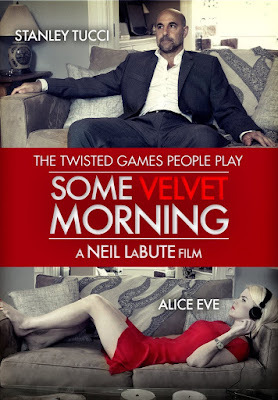
In playwright Neil LaBute’sfilm, Some Velvet Morning, Stanley Tucci is hardly thinking aboutbecoming the next pope. Instead, in this chamber piece from 2013, Tucci’s hoton the trail of an enigmatic young woman who may or may not be named Velvet.LaBute himself personally suggested that I watch this flick, based on myappreciation for an earlier LaBute cinematic work, The Shape of Things.Now that I’ve seen Some Velvet Morning, I can understand why it hasdivided critics and audiences, even those of the film-festival-going variety.Yes, the writer/director displays in this film his usual mastery of dialogueand his gift for ambiguous characterizations, but I can understand how somemoviegoers have come away from it annoyed and even offended. Still, I found it,when all was said and done, genuinely bracing.
Part of the challenge of SomeVelvet Morning comes from the audience’s need to figure out just what isgoing on. We start with a languid young woman in a bright red minidressstretched out on a sofa in an oh-so-pristine townhouse. Then a well-dressedolder gentleman carrying quite a lot of luggage rings her doorbell, and thefilm kicks into action. These two apparently know each other, though there’sbeen a long absence, and the viewer is tasked with figuring out exactly whatexists between them.
Perhaps the most instructivemoment occurs at the end of the credit sequence, when five words appear on thescreen: For August Strindberg, with Love. LaBute, a serious student ofclassic drama, was clearly influenced on this project by the 19thcentury Swedish author of intimate plays like Miss Julie, in which thebattle of the sexes plays out with dramatic ferocity. As always, LaBute’sscreenwork here feels much like a stage play, with sharply articulated dialoguebriskly moving the action forward. But there’s also the vividly cinematic useof the full townhouse set, including steep staircases and well-decorated nooksand crannies to add some visual reality to the story’s twists and turns.
Watching the plot unfold, Iwas struck anew by Tucci’s talent for naturalistic performance. Whatever hismood at any given moment, he’s totally credible, even when lashing out withlightning speed. In both his character’s neediness and his anger, he seemscompletely real. His opposite number, Alice Eve, was unknown to me. As shechanged moods and approaches to the man at the door, I sensed there wassomething histrionic about her, in contrast to Tucci’s more internalizedperformance. In time, though, I questioned my own earlier judgment. That’s whatthis film does to you.
I won’t go into where it allleads. But at the end of this relatively short film (all of 82 minutes), theviewer should acknowledge having been on quite a journey, one whose conclusionhe or she had not quite anticipated. (It’s hardly surprising to me that noteveryone is pleased with this outcome.)
I should add that the film’scurious title was apparently borrowed from a Lee Hazlewood song from 1967, bestknown from a recording in which he duets with Nancy Sinatra on her “Movin’ withNancy” album. One critic said at the time, “’Some Velvet Morning’ sounds liketwo songs spliced together by a madman, or an avant-garde short film in songform.” Its lyrics are famously enigmatic, having puzzled critics and fans forgenerations. Hazelwood has confirmed that in writing the song he was thinkingabout classical Greek mythology, and particularly with the beautiful butdangerous Phaedra, whose love life was certainly complicated. Does the songhelp explain LaBute’s story? Well, maybe, or maybe not.
Beverly in Movieland
- Beverly Gray's profile
- 10 followers



